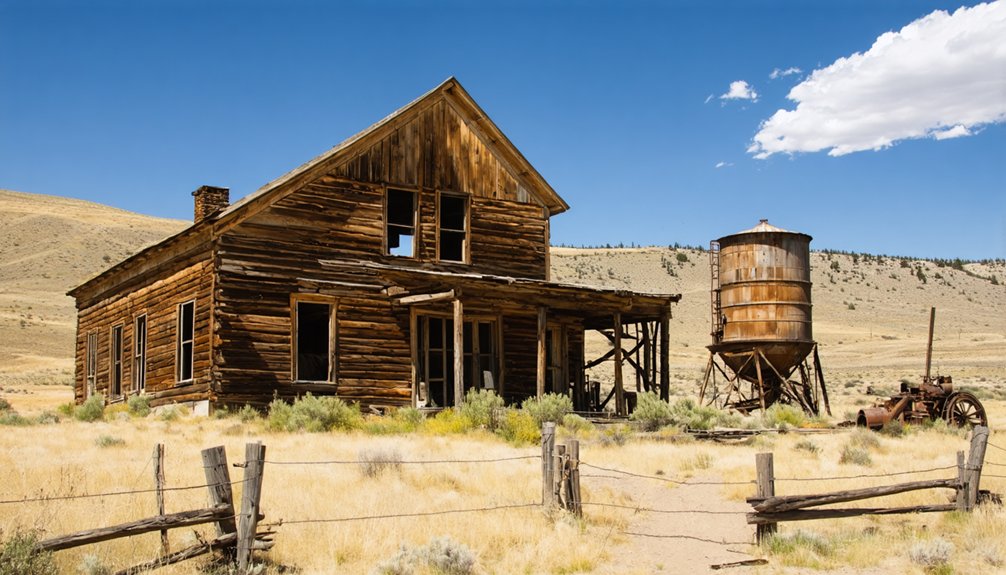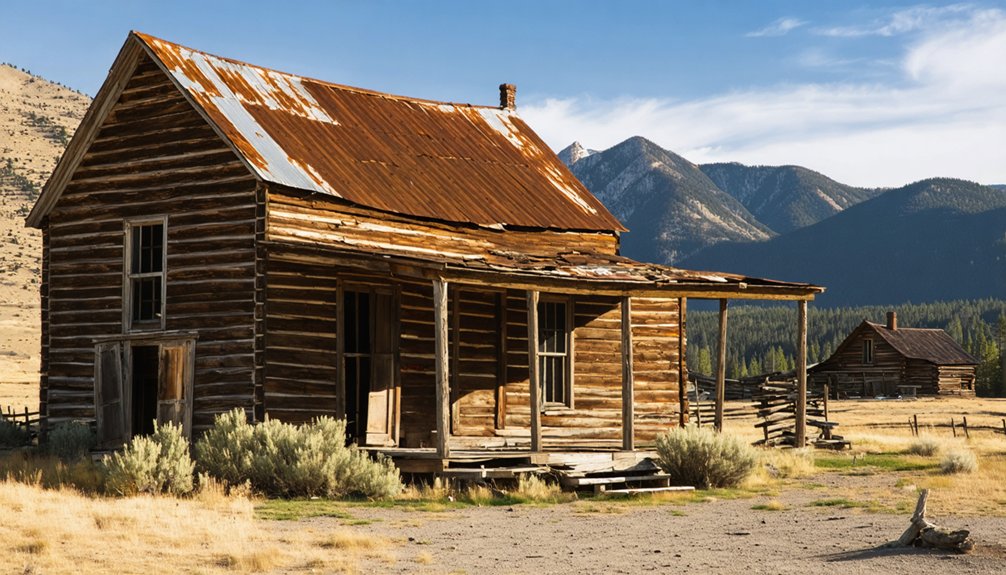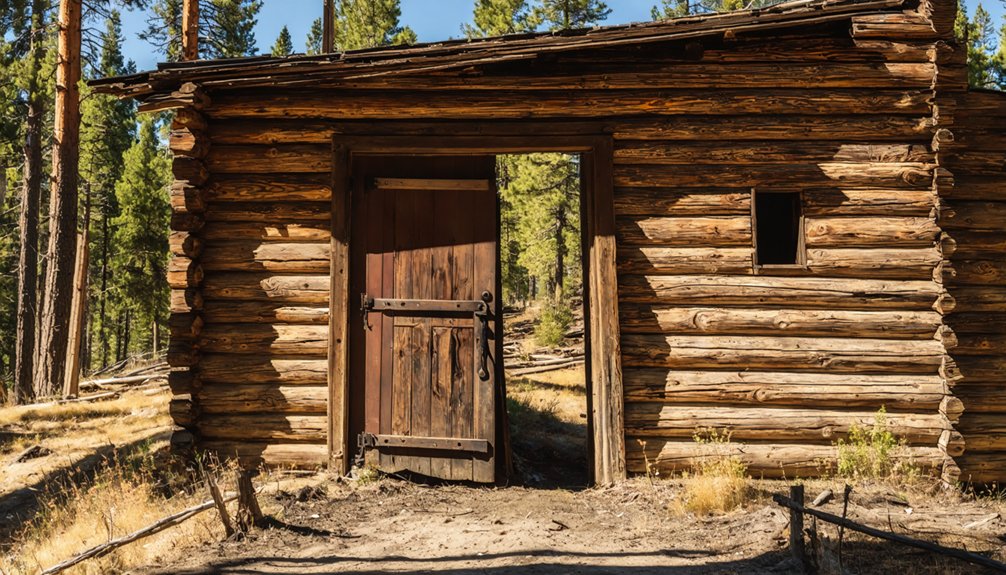You’ll find Aline perched at 6,500 feet in Idaho’s central mountains, where silver-lead-zinc deposits sparked a mining boom in 1884. The Bunker Hill mine, America’s largest underground operation, anchored this frontier town in the legendary Silver Valley. While most structures have surrendered to nature over 120 years of abandonment, Aline’s story lies in its preserved artifacts, mining remnants, and the echoes of a community that extracted over 1.18 billion ounces of silver.
Key Takeaways
- Aline originated during the 1884 silver mining boom, becoming a significant settlement within Idaho’s Silver Valley following the Bunker Hill mine establishment.
- Located at 6,500 feet elevation in central Idaho’s mountains, Aline is surrounded by steep slopes and dense pine forests.
- The town flourished with silver-lead-zinc mining operations, supporting up to 180 workers at the Galena Mine during peak production.
- A devastating 1923 fire destroyed over 50 commercial buildings in Burke Canyon, contributing to the town’s eventual abandonment.
- Few original structures remain after 120 years, with natural vegetation reclaiming the remote site that’s accessible via rough gravel roads.
The Mining Boom Era Origins
Three pivotal factors shaped Aline’s mining boom origins in Idaho’s mineral-rich landscape.
First, you’ll find the region’s transformation began with placer mining discoveries that quickly evolved into sophisticated hard-rock operations, particularly after the establishment of the Bunker Hill mine in 1885. The discovery of silver-lead-zinc deposits in 1884 catalyzed the area’s mining expansion. The Bunker Hill operation became the largest underground mine in the United States, fundamentally changing the region’s mining landscape.
Second, the Coeur d’Alene area’s remarkable silver and lead deposits positioned Aline at the heart of what would become the legendary Silver Valley, home to some of the world’s richest metal deposits.
The Silver Valley’s immense mineral wealth transformed Aline into a crucial hub within Idaho’s most productive mining district.
Third, the area’s rapid development was driven by a transient population of fortune-seekers who followed the latest mineral strikes.
This constant flux of miners and prospectors created a dynamic but unstable settlement pattern that would ultimately influence Aline’s destiny as a ghost town.
Geographic Location and Terrain
You’ll find Aline nestled in the rugged central Idaho mountains, where its remote setting at roughly 6,500 feet elevation creates challenging access conditions even today.
The ghost town’s position in a mining camp valley within the Challis district speaks to its strategic placement near mineral deposits and water sources essential for mining operations.
The surrounding terrain features steep slopes, rocky outcrops, and mixed pine-sagebrush vegetation typical of Idaho’s mountainous mining regions, with access primarily via rough gravel roads that wind through the demanding landscape. The arid climate conditions have helped preserve many of the abandoned structures at the site. Visitors exploring the area should follow established trails to help protect the historic mining remains and natural environment.
Mountain Setting and Access
Nestled within Idaho’s central-northern mountains, Aline stands as a tribute to the region’s rugged mining history.
You’ll find the ghost town surrounded by steep slopes and dense pine forests typical of the Salmon River Mountains and Sawtooth Range. Mountain access requires careful navigation of unpaved gravel roads that wind through narrow valleys and rocky terrain.
The site’s high elevation creates significant terrain challenges, especially during winter months when snow and ice limit accessibility. Similar conditions affect nearby attractions like Crystal Gold Mine tours in Kellogg, which draw visitors year-round.
You’ll need a high-clearance, four-wheel-drive vehicle to tackle the rough mountain roads. Spring melts and autumn rains can make travel particularly treacherous.
The surrounding landscape features thick sagebrush, hidden streams, and geological formations that once attracted miners to this remote mountain outpost. Like many sites along the Oregon Trail, Aline began as a temporary settlement before the discovery of precious metals transformed it into a bustling mining camp.
Mining Camp Valley Position
Contrary to the remote mountain setting described above, Aline’s valley location offers a distinctly different geographical context.
You’ll find this ghost town exploration site nestled in Idaho’s Teton Basin, where the terrain stretches flat and open at roughly 6,000 feet elevation, flanked by the dramatic Teton Range and Big Hole Mountains.
Unlike Idaho’s famous mining camps that required complex mining techniques in steep terrain, Aline sat on accessible valley ground within the graben formation. This contrasts sharply with towns like Eagle City, where gold rush fever drove miners into the challenging Coeur d’Alene mountains.
The site sits among historical ghost towns that the Idaho State Historical Society has documented since 1964.
The site’s position in the broad, wind-swept basin supported early agricultural efforts rather than mineral extraction.
You’re looking at a settlement that developed on sagebrush steppe terrain, with seasonal streams feeding into the northward-flowing Teton River.
This valley positioning ultimately shaped Aline’s brief existence and eventual abandonment.
Mining Operations and Mineral Wealth
Located in one of the world’s most prolific silver regions, Aline’s mining operations centered around the rich silver-lead deposits of the Coeur d’Alene district, which has produced over 1.18 billion ounces of silver since 1884.
The district’s high silver content attracted significant investment and development in the 1890s. You’ll find evidence of extensive mineral extraction throughout the area, particularly at the Galena Mine, where ore processing reached depths of 3,000 feet after Asarco’s 1947 discovery. The mining infrastructure evolved from basic timber-framed shafts to sophisticated mechanized operations using mucking machines and improved extraction techniques. U.S. Silver Corporation took control after Coeur Mining sold its interests in 2006.
While silver-lead ores dominated production, mining companies later diversified into gold ventures.
The scale of operations supported hundreds of workers, with the Galena Mine alone employing 180 people as recently as 2005-2006, showcasing the industry’s lasting economic impact on the region.
Daily Life in a Frontier Mining Town
Life in Aline revolved around three distinct social tiers: the wealthy mine owners and merchants, middle-class shopkeepers and skilled workers, and the laboring class of miners and transient workers.
You’d find daily routines centered on community survival, with neighbors helping each other build cabins, maintain roads, and share resources during harsh times.
While miners toiled in dangerous conditions, women managed households, ran boarding houses, and provided essential services.
Cultural activities offered relief from the demanding work schedule – you could attend church services, community fairs, or enjoy evening entertainment at the saloon.
The town’s ethnic makeup included immigrant groups, particularly Chinese laborers who worked abandoned claims.
Despite primitive conditions and limited amenities, residents fostered a tight-knit community through shared meals, social gatherings, and mutual support.
Rise and Fall of Population

You’ll find that Aline’s population never reached the dramatic numbers of Idaho’s mining boomtowns, instead remaining a modest settlement of Mormon farmers and ranchers in the tens to low hundreds.
The community’s earliest residents concentrated around essential services like the post office and LDS ward, with demographic records showing primarily agricultural families rather than the diverse mix found in mining camps.
The town’s gradual decline tracked with the economic rise of nearby Driggs, as families steadily relocated until no permanent residents remained at the original settlement site.
Peak Mining Era Numbers
During the peak mining era, Aline’s population fluctuated dramatically in response to ore discoveries, metal prices, and industrial developments.
Like other mining camps in the region, you’ll find that employment trends directly influenced the town’s size, with significant workforce changes during the 1880s gold rush and subsequent industrial mining periods.
Key mining statistics from Aline’s heyday reveal:
- Workforce numbers similar to the Galena Mine’s 180 workers during full production phases
- Population spikes into the thousands during major ore discoveries
- Sharp declines during the Great Depression and metal price drops
The town’s population mirrored the broader mining district’s pattern, where settlements expanded rapidly between 1880-1910, followed by gradual decline as operations shifted from surface to deep mining, requiring fewer but more specialized workers.
Early Settlement Demographics
While population records from Aline’s peak mining era paint a picture of industrial growth, the early settlement patterns reveal a more complex demographic story.
You’ll find that Aline’s initial population shifts were deeply influenced by the region’s economic opportunities, particularly in mining and agriculture. The settlement likely experienced the typical boom-and-bust cycle common to Idaho mining towns, with rapid growth during resource discoveries followed by decline as deposits were depleted.
Cultural influences shaped the settlement’s demographic makeup, as Native American communities intersected with waves of European settlers drawn by mining prospects.
Like many small Idaho settlements, Aline’s population would have fluctuated with the ebb and flow of mining activities, though specific numbers remain elusive due to limited historical documentation of smaller settlements from this period.
Exodus and Final Residents
As Mormon families established Aline in 1888, the settlement’s population trajectory followed a brief but distinctive arc through the early 20th century. The town’s population dynamics peaked in the late 1890s before a steady decline set in by 1901, leading to the final exodus that transformed Aline into a ghost town by the 1920s.
Key factors that drove residents away:
- Limited economic prospects in the harsh high desert environment
- Lack of sustainable infrastructure and essential services
- Growing isolation as neighbors departed for better opportunities
You’ll find that the last inhabitants, primarily aging residents, faced mounting challenges as community services disappeared. The closure of postal and educational facilities accelerated the exodus, while dwindling resources made daily life increasingly difficult.
Today, Aline’s deteriorating structures stand as silent witnesses to this population shift.
Notable Buildings and Infrastructure

The architectural legacy of Aline’s notable buildings reflects the town’s mining-era prosperity through a mix of commercial, industrial, and residential structures.
You’ll find construction styles typical of late 19th to early 20th century Idaho mining towns, with brick and stone buildings that have withstood time’s passage.
Like other ghost towns in the region, Aline’s historic architecture includes abandoned commercial spaces and miners’ cabins that cling to mountainsides.
The industrial remnants of mining operations, from ore processing facilities to transport infrastructure, paint a picture of the town’s economic foundation.
Some locals whisper about ghostly encounters in these weathered structures, particularly in the commercial buildings where business once thrived.
Today, these silent sentinels stand as evidence of Idaho’s rugged mining heritage.
Natural Disasters and Deterioration
Nature released its fury on Aline through devastating avalanches, fires, and landslides that accelerated the town’s deterioration.
The combination of natural disasters and environmental impact from mining activities proved catastrophic for this mountain community. You’ll find most original wooden structures have succumbed to destruction, while only a few sturdy mining buildings remain standing against the harsh elements.
Mining and nature’s wrath decimated the mountain town, leaving only the strongest structures to weather time’s relentless march.
- The massive fire of July 14, 1923, destroyed over 50 commercial buildings in nearby Burke Canyon, leaving 600 residents homeless.
- Avalanches repeatedly damaged structures in the steep terrain, with many buildings now barely clinging to canyon walls.
- A devastating landslide, spanning 3 miles long and 200 feet high, dammed water and flooded parts of nearby Roosevelt.
Today, you’ll encounter fenced-off ruins and warning signs, evidence of both nature’s power and mining’s lasting environmental toll.
Tales and Legends From the Past

Deep within Aline’s rugged landscape, fascinating tales of miners, pioneers, and mysterious happenings echo through time.
You’ll find ghost stories woven into the fabric of this former mining settlement, much like other Idaho ghost towns where restless spirits are said to roam abandoned structures and forgotten streets.
Local folklore speaks of star-crossed lovers, tragic mining accidents, and unexplained phenomena that mirror the tales found throughout Idaho’s mining history.
Just as the Idanha Hotel carries its ghostly reputation, Aline’s weathered buildings hold their own mysteries.
You’re walking in the footsteps of countless miners who sought their fortunes here, their stories preserved through oral traditions passed down through generations.
These narratives reflect the broader cultural heritage of Idaho’s mining communities, where reality and legend often intertwine.
Current State and Remaining Structures
You’ll find few physical remnants of Aline’s original structures today, as over 120 years of abandonment have left this ghost town in an advanced state of deterioration.
The wooden buildings that once housed Mormon settlers have largely collapsed or disappeared entirely, with any remaining ruins likely limited to scattered foundations or partially standing walls.
The site’s remote location in Teton County has contributed both to its preservation from vandalism and to the lack of organized conservation efforts, leaving the ruins to gradually merge with the surrounding landscape.
Physical Ruins Today
While thorough documentation of Aline’s physical remains is considerably absent from available sources, the current state of this Idaho ghost town remains largely unknown.
If you’re planning to explore this mysterious site, you’ll need to contemplate its potential physical condition based on patterns seen in other Idaho ghost towns.
- You might discover foundations, cellar holes, or partial wall remnants typical of long-abandoned sites, though their presence can’t be confirmed without direct observation.
- Any potential discoveries could include traces of infrastructure like old wagon roads or railway grades that once served the settlement.
- The site may now be considerably reclaimed by nature, with vegetation obscuring whatever structural remains might exist.
Without verified records or recent surveys, Aline’s ruins await proper documentation and study by interested explorers.
Preservation and Safety Issues
Since Aline’s current preservation status remains undocumented, safety considerations must be evaluated through the broader lens of Idaho ghost town management practices.
You’ll find typical preservation challenges at ghost town sites include structural instability, environmental hazards from mining activities, and ongoing deterioration from weather exposure.
Standard safety measures you’d likely encounter at Aline align with other Idaho ghost towns – potentially including warning signage, restricted access areas, and protective fencing around unstable structures.
While federal and state agencies often oversee ghost town preservation efforts, remote locations can complicate consistent monitoring and maintenance.
If you’re planning to explore Aline’s remains, you’ll need to exercise caution, as aging infrastructure and natural decay create increasing safety risks over time without active preservation intervention.
Historical Preservation Efforts
Through coordinated efforts by organizations and government agencies, Idaho’s ghost towns receive varying levels of preservation support to protect their historical significance.
You’ll find community involvement and restoration techniques being taught at places like The Atlanta School, where hands-on workshops focus on vernacular construction and material maintenance.
- Historic preservation mapping through GIS overlays helps identify and protect archaeological sites during development
- Educational programs draw artists, historians, and naturalists to contribute specialized knowledge
- Documentation and structural assessments guide preservation priorities for remaining buildings
The preservation approach balances protecting architectural integrity while promoting public access and historical awareness.
Local agencies like Kootenai County actively support these efforts through regulations and museum partnerships, ensuring Idaho’s mining heritage remains accessible for future generations to explore and understand.
Frequently Asked Questions
Are There Any Documented Deaths or Accidents in Aline’s Mines?
Silent as the stones that remain, you won’t find documented fatalities or mine accidents specific to Aline’s operations, though the broader Silver Valley region experienced numerous mining-related tragedies.
What Native American Tribes Originally Inhabited the Area Before Mining?
You’ll find the Coeur d’Alene Tribe primarily inhabited this region, though the Kootenai also maintained a presence. While Shoshone and Bannock tribes lived in Idaho, they weren’t specifically tied to Aline’s location.
Did Any Famous Outlaws or Historical Figures Visit Aline?
You won’t find records of famous visitors or historical figures in Aline’s past. While outlaws roamed Idaho’s mining towns, historical documentation doesn’t indicate any notable personalities made their way to this particular spot.
Were There Any Unique Local Laws or Regulations Specific to Aline?
You won’t find any documented unique regulations specific to Aline in historical records. Local governance likely followed standard territorial mining codes rather than establishing distinct municipal laws.
What Happened to the Mining Equipment and Machinery After Abandonment?
Like scattered bones of industry past, you’ll find most mining relics preservation efforts failed here – nature reclaimed machinery while regulations prevented removal, and what wasn’t salvaged slowly deteriorated from exposure.
References
- https://cdapress.com/news/2024/sep/05/over-the-hill-exploring-north-idahos-very-own-ghost-town/
- https://www.thegoldminehotel.com/ghost-towns-and-haunted-places-in-idaho
- https://history.idaho.gov/wp-content/uploads/2018/08/0064.pdf
- https://www.youtube.com/watch?v=jcXqq2uekrM
- https://idaho-forged.com/idahos-ghost-towns-eerie-yet-approachable/
- https://en.wikipedia.org/wiki/List_of_ghost_towns_in_Idaho
- https://visitidaho.org/things-to-do/ghost-towns-mining-history/
- https://idgenweb.org/archives/history-ghost+towns.html
- https://www.idahogeology.org/pub/Pamphlets/P-133.pdf
- https://pubs.usgs.gov/bul/b2064-t/b2064-t.pdf



